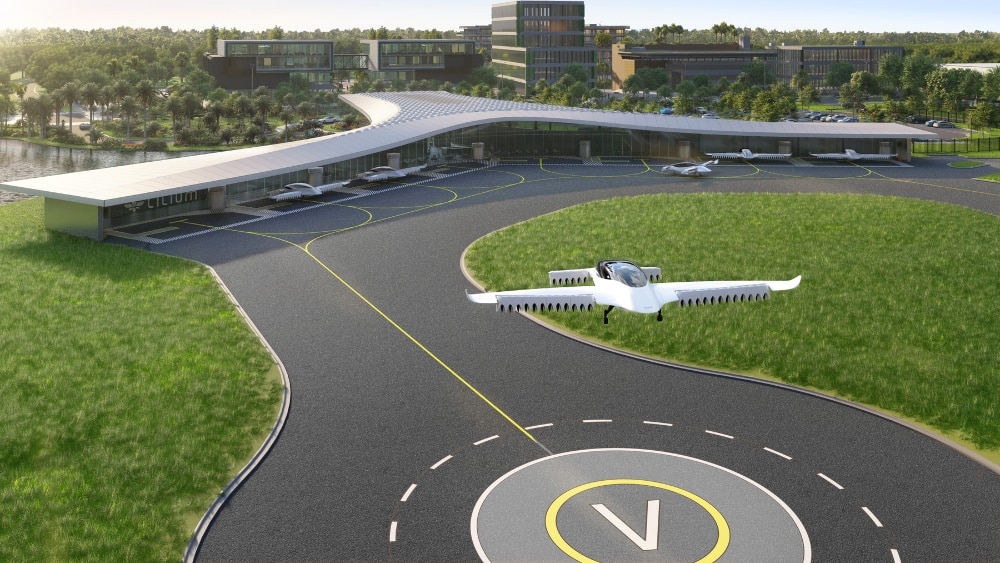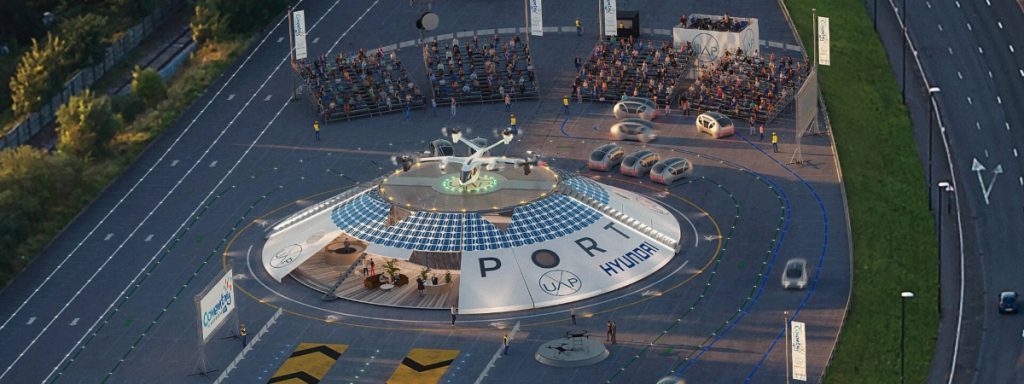Lilium, Hyundai, and Airbus Are All Betting Big on Taxi Drones—But When Will They Actually Take Flight?
BY Zacc Dukowitz
4 February 2021Back in 2017, we wrote a year in review about taxi drones.
In case you don’t remember, that year saw some real progress on the passenger drone front.
Companies like Ehang, Uber Elevate, and AirBus were all investing heavily in the technology, and cities like Los Angeles, Dallas, and Dubai, as well as the entire state of Nevada, all seemed poised to start using taxi drones in some limited form in the near future.

An illustration released by Uber Elevate in 2017
But since then momentum has flagged, at least from an implementation perspective. Dubai’s drone taxi program—which was supposed to start in the summer of 2017—never launched, Uber has sold off its drone taxi unit, and there still aren’t any cities anywhere in the world that actually use passenger drones.
And yet things are moving forward, just not as quickly as we’d once imagined.
Recently, Lilium announced a significant investment in the creation of taxi drone hubs in Florida, Hyundai announced an investment in creating infrastructure to test its drone taxis, and the EU just launched a huge two-year project to test drone taxis and related technology.
Let’s take a look at these developments to see what they might tell us about the future of passenger drones, and when they might actually start being available for use.
Quick Definitions
Like everything in the drone industry, drone taxis come with their own language and acronyms.
Here are some important definitions:
- UAM. Urban Air Mobility—refers generally to large unmanned vehicles used primarily as taxi drones or for cargo drone delivery in urban and suburban areas. Learn more on the FAA’s website.
- AAM. Advanced Air Mobility—refers to large unmanned vehicles used in areas that are not urban (basically taking UAM and expanding it to apply to any type of flying environment). Learn more on the FAA’s website.
- eVTOL. Electric Vertical Takeoff and Landing—refers to the technology being developed and used for taxi drones, which allows for vertical takeoff in congested urban environments, similar to how helicopters take off and land. Watch a presentation from the FAA and NASA on eVTOL.

Image credit: Ehang
Lilium Plans $25 Million Vertiport Hub in Orlando
A few months back, German drone taxi startup Lilium announced plans to build a 56,000-square-foot transportation hub—called a Vertiport—in Orlando, FL.

Image credit: Lilium
The price tag for the vertiport is $25 million. Lilium believes its drone taxi service will be operational by 2025, offering short trips in the Orlando area with its electric five-seater Lilium Jet (featured in the video below).
Some of Lilium’s financial risk in the Vertiport investment is being mitigated by the city of Orlando, which has reportedly agreed to give the company over $830,000 in tax breaks in the hopes that the Vertiport will bring jobs and revenue to the area.
Even with this support, it’s still remarkable that Lilium is making such a huge investment without yet having the regulatory approval to operate.
But the company certainly has the funds to support the investment—so far it has raised over $340 million in startup capital, with $240 million raised last year alone.
Hyundai Partners with the U.K. to Create UAM Test Site
Hyundai’s Urban Air Mobility Division recently announced that it’s partnering with the U.K. to develop a site for testing the use of taxi drones.
The site will be called Air One, and it will be built by Urban Air Port, a U.K.-based company focused on creating infrastructure to support UAM.


Image credit: Urban Air Port
The Air One test site will employ the same basic concept as Lilium’s Vertiport—it’s a place where taxi drones can land and take off—except that its sole focus will be on testing passenger drones toward the goal of building the infrastructure needed to support their use.
The project is supported by funding from Hyundai and from the U.K.’s Future Flight Challenge, which has granted 1.6 million (1.2 million pounds) for the development of the site.
According to a recent press release from Hyundai, UAM isn’t just about convenience—it’s also crucial for reducing our carbon footprint.
Using innovative construction, the sites can be installed in a matter of days, emit net zero carbon emissions and can be operated completely off-grid, meaning they do not always have to rely on a suitable grid connection.
– Hyundai
Urban Air Port is so confident in the future of UAM that it has pledged to create 200 zero emission sites throughout the world over the next five years.
EU Plans Intensive UAM Testing Over Next Two YEars
The European Union just started testing taxi drones and other UAM as part of a huge project called Air Mobility Urban—Large Experimental Demonstration (“AMU-LED”).
The AMU-LED [has] the ultimate goal of showcasing one of the largest demonstrations of mobility services with air vehicles and the safe integration of different types of drone operations . . . in urban environments to realize increasingly sustainable, smart cities by 2022.
– Ehang press release
The project features 17 different companies, including Boeing, Airbus, and Ehang. Over the next two years, member companies will conduct UAM tests in Spain, the U.K., and the Netherlands.
The final goal of the project is to complete over 100 hours of tests flights, demonstrating the reliability of UAM technology for:
- Air taxis
- Cargo transport
- Delivery of goods and medical equipment
- Inspection of infrastructures
- Police surveillance
- Emergency services support
But Can I Catch a Ride in a Drone Already?
Still wondering when you’ll be able to hail a ride in a taxi drone?
By way of answering that question, let’s sum up the goals of the companies we’ve covered in this article for the next seven years:
- The EU plans to complete over 100 hours of test flights for UAM by 2023
- Lilium plans to launch regular drone taxi flights by 2025
- Urban Air Port plans to build 200 UAM Air Port sites by 2026
- Hyundai plans to launch its taxi drone commercially by 2028
Based on this information, we’d guess that it could realistically be another ten years before taxi drones arrive in a city near you. (Sure, Lilium says you’ll be able to do it in just four years if you live in Orlando—but we’re a little skeptical, given the current lack of regulatory approval.)
Whether it’s five years, or ten, or fifteen, it’s clear that real progress is being made on the taxi drone front, and that companies are investing heavily in creating the future of UAM.
Now the question is—would you actually ride in one? Share your thoughts in this thread on the UAV Coach community forum.


